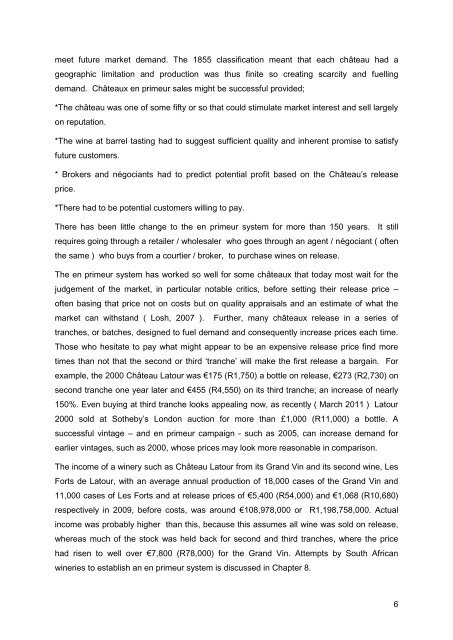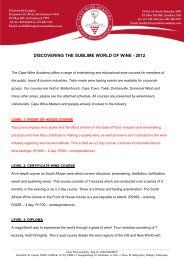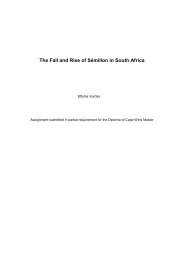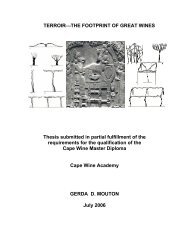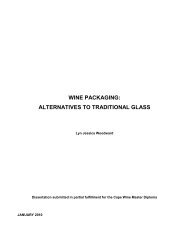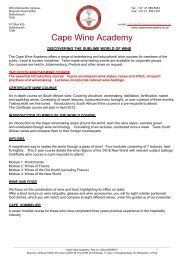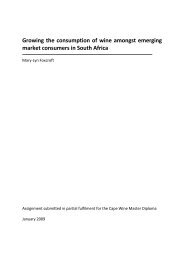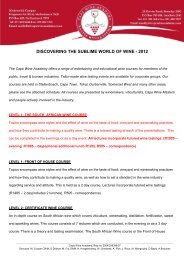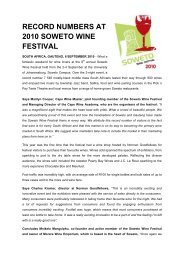Wine Investment in South Africa - Cape Wine Academy
Wine Investment in South Africa - Cape Wine Academy
Wine Investment in South Africa - Cape Wine Academy
You also want an ePaper? Increase the reach of your titles
YUMPU automatically turns print PDFs into web optimized ePapers that Google loves.
meet future market demand. The 1855 classification meant that each château had a<br />
geographic limitation and production was thus f<strong>in</strong>ite so creat<strong>in</strong>g scarcity and fuell<strong>in</strong>g<br />
demand. Châteaux en primeur sales might be successful provided;<br />
*The château was one of some fifty or so that could stimulate market <strong>in</strong>terest and sell largely<br />
on reputation.<br />
*The w<strong>in</strong>e at barrel tast<strong>in</strong>g had to suggest sufficient quality and <strong>in</strong>herent promise to satisfy<br />
future customers.<br />
* Brokers and négociants had to predict potential profit based on the Château’s release<br />
price.<br />
*There had to be potential customers will<strong>in</strong>g to pay.<br />
There has been little change to the en primeur system for more than 150 years. It still<br />
requires go<strong>in</strong>g through a retailer / wholesaler who goes through an agent / négociant ( often<br />
the same ) who buys from a courtier / broker, to purchase w<strong>in</strong>es on release.<br />
The en primeur system has worked so well for some châteaux that today most wait for the<br />
judgement of the market, <strong>in</strong> particular notable critics, before sett<strong>in</strong>g their release price –<br />
often bas<strong>in</strong>g that price not on costs but on quality appraisals and an estimate of what the<br />
market can withstand ( Losh, 2007 ). Further, many châteaux release <strong>in</strong> a series of<br />
tranches, or batches, designed to fuel demand and consequently <strong>in</strong>crease prices each time.<br />
Those who hesitate to pay what might appear to be an expensive release price f<strong>in</strong>d more<br />
times than not that the second or third ‘tranche’ will make the first release a barga<strong>in</strong>. For<br />
example, the 2000 Château Latour was €175 (R1,750) a bottle on release, €273 (R2,730) on<br />
second tranche one year later and €455 (R4,550) on its third tranche; an <strong>in</strong>crease of nearly<br />
150%. Even buy<strong>in</strong>g at third tranche looks appeal<strong>in</strong>g now, as recently ( March 2011 ) Latour<br />
2000 sold at Sotheby’s London auction for more than £1,000 (R11,000) a bottle. A<br />
successful v<strong>in</strong>tage – and en primeur campaign - such as 2005, can <strong>in</strong>crease demand for<br />
earlier v<strong>in</strong>tages, such as 2000, whose prices may look more reasonable <strong>in</strong> comparison.<br />
The <strong>in</strong>come of a w<strong>in</strong>ery such as Château Latour from its Grand V<strong>in</strong> and its second w<strong>in</strong>e, Les<br />
Forts de Latour, with an average annual production of 18,000 cases of the Grand V<strong>in</strong> and<br />
11,000 cases of Les Forts and at release prices of €5,400 (R54,000) and €1,068 (R10,680)<br />
respectively <strong>in</strong> 2009, before costs, was around €108,978,000 or R1,198,758,000. Actual<br />
<strong>in</strong>come was probably higher than this, because this assumes all w<strong>in</strong>e was sold on release,<br />
whereas much of the stock was held back for second and third tranches, where the price<br />
had risen to well over €7,800 (R78,000) for the Grand V<strong>in</strong>. Attempts by <strong>South</strong> <strong>Africa</strong>n<br />
w<strong>in</strong>eries to establish an en primeur system is discussed <strong>in</strong> Chapter 8.<br />
6


